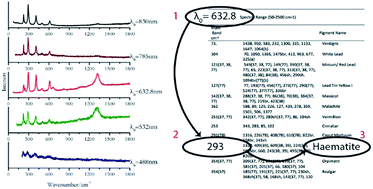当前位置:
X-MOL 学术
›
Anal. Methods
›
论文详情
Our official English website, www.x-mol.net, welcomes your feedback! (Note: you will need to create a separate account there.)
Raman spectroscopic library of medieval pigments collected with five different wavelengths for investigation of illuminated manuscripts†
Analytical Methods ( IF 3.1 ) Pub Date : 2018-02-20 00:00:00 , DOI: 10.1039/c8ay00016f G. Marucci 1, 2, 3, 4 , A. Beeby 4, 5, 6 , A. W. Parker 4, 7, 8 , C. E. Nicholson 1, 2, 3, 4
Analytical Methods ( IF 3.1 ) Pub Date : 2018-02-20 00:00:00 , DOI: 10.1039/c8ay00016f G. Marucci 1, 2, 3, 4 , A. Beeby 4, 5, 6 , A. W. Parker 4, 7, 8 , C. E. Nicholson 1, 2, 3, 4
Affiliation

|
Raman spectroscopy is widely applied in the cultural heritage field to perform non-destructive measurements in situ, in order to identify materials, specifically pigments. The spectra collected can be challenging to interpret because certain source laser wavelengths may be absorbed by specific pigments, leading to large fluorescence backgrounds which obscure the weak Raman signals, or worse cause photodegradation of the sample. Furthermore, the reference spectra for a specific pigment obtained from a particular laser wavelength is not always available and is a crucial step in the detective work of pigment identification, especially when the resonance Raman effect can enhance some signals. As the range of lasers available increases, spectral libraries do not always record spectra acquired with the same wavelength used to carry out the measurements in field. In this work, reference spectra of 32 different compounds, mostly used in mediaeval manuscripts as pigments and inks, are recorded. Five different wavelengths were used as excitation sources. The aim is to provide a useful and more complete reference source to enable better planning of which laser wavelength is the most appropriate to study a specific set of pigments, and to allow comparisons between spectra acquired with the same wavelength, leading to the unequivocal pigment identification in a step by step manner.
中文翻译:

收集了五种不同波长的中世纪颜料的拉曼光谱库,用于研究照明手稿†
拉曼光谱被广泛应用于文化遗产领域,以进行原位非破坏性测量,以便识别材料,特别是颜料。收集的光谱难以解释,因为某些源激光波长可能被特定的颜料吸收,从而导致大的荧光背景,使弱的拉曼信号模糊,或者更糟的是导致样品的光降解。此外,从特定激光波长获得的特定颜料的参考光谱并不总是可用,并且是颜料识别检测工作中的关键步骤,尤其是当共振拉曼效应可以增强某些信号时。随着可用激光范围的增加,光谱库并不总是记录以与用于现场测量的波长相同的波长采集的光谱。在这项工作中,参考了32种不同化合物的光谱,大多记录在中世纪手稿中,用作颜料和油墨。五个不同的波长被用作激发源。目的是提供有用且更完整的参考源,以便更好地计划最适合研究特定颜料组的激光波长,并允许在相同波长下获得的光谱之间进行比较,从而明确颜料的识别一步一步地
更新日期:2018-02-20
中文翻译:

收集了五种不同波长的中世纪颜料的拉曼光谱库,用于研究照明手稿†
拉曼光谱被广泛应用于文化遗产领域,以进行原位非破坏性测量,以便识别材料,特别是颜料。收集的光谱难以解释,因为某些源激光波长可能被特定的颜料吸收,从而导致大的荧光背景,使弱的拉曼信号模糊,或者更糟的是导致样品的光降解。此外,从特定激光波长获得的特定颜料的参考光谱并不总是可用,并且是颜料识别检测工作中的关键步骤,尤其是当共振拉曼效应可以增强某些信号时。随着可用激光范围的增加,光谱库并不总是记录以与用于现场测量的波长相同的波长采集的光谱。在这项工作中,参考了32种不同化合物的光谱,大多记录在中世纪手稿中,用作颜料和油墨。五个不同的波长被用作激发源。目的是提供有用且更完整的参考源,以便更好地计划最适合研究特定颜料组的激光波长,并允许在相同波长下获得的光谱之间进行比较,从而明确颜料的识别一步一步地


























 京公网安备 11010802027423号
京公网安备 11010802027423号